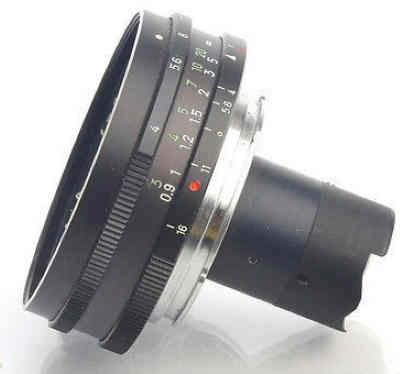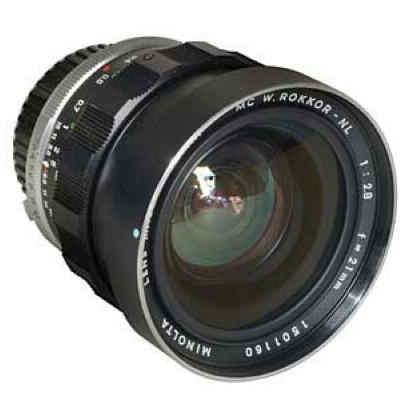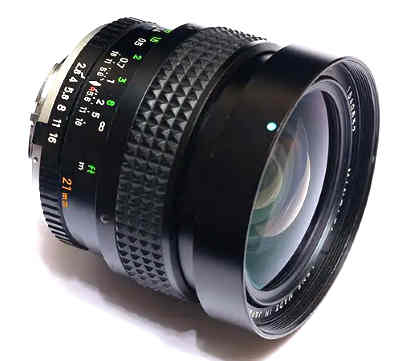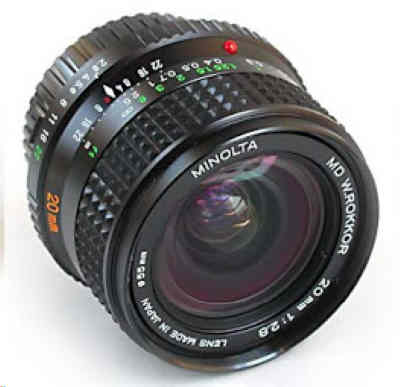MINOLTA 20mm & 21mm LENSES
Minolta has a long history of making super-wide-angle lenses. One of the drawbacks to the
use of early SLR cameras was the lack of super wide-angle lenses. A 28mm lens was as wide as you could expect
to find on an SLR. The problem was that a super-wide lens had to be so deeply recessed into the camera body
that the SLR's mirror would be blocked from moving out of the light path by the back of the lens. (This was
not a problem with other types of cameras, such as rangefinders, that lacked the reflex mirror.) Minolta
came up with an innovative solution in 1962 and built a mirror lock-up into their SR-7 (and many later) camera.
By moving the mirror up and out of the way, deeply recessed lenses could be used. Since the mirror
was now in the "up" position, the viewfinder was blacked-out and the subject could not be viewed. Minolta
solved this problem by selling a separate viewfinder with the super-wide 21mm lenses.
The 21mm & 20mm lenses aren't for everyone. Although they are rectilinear optics, so
lines appear straight, the superwide angle of view requires careful use. Some people don't like the photographic
effect, and some people are even disturbed by its distortion. Subjects far away almost disappear, while objects
near to the lens look enormous. But with attention to detail, striking landscapes capturing near and far
objects, can be obtained. It can also be useful for interiors, but caution is advised in these situations.
If people are in the scene, they can appear distorted, with the parts of their body closest to the lens looking
abnormally large.
The angle of view of these lenses is so wide that ghosting is a real problem. If you are taking
pictures during the day, there is a good chance that the sun will get into the picture and create those multi-colored
streams of reflections. This will happen with any version of these lenses and is not significantly diminished
with the newer lens coatings. While this effect is sometimes desirable, most of us instinctively reach for
a lens shade. Fortunately, these were provided with these lenses, and are essential to their use.
In addition, these lenses, like all superwide optics, suffers from light fall-off. In other
words, the edges and corners of the image receive less light than the middle of the picture and can appear slightly
darker, especially with large, smooth-toned images like a blue sky. The effect can be minimized by stopping
down the lens as much as possible. Keep in mind that the effect can be advantageous with some subjects and
can be minimized in the darkroom, if necessary. Another alternative is to purchase a graduated neutral-density
filter which counteracts the light fall-off at the widest apertures.
The Minolta 20mm lenses employ a floating element design to improve image quality at close distances.
The only drawback is that the front of the lens rotates as the lens is focused. Normally, this is not
a problem, but if a polarizer is being used, the polarizing effect will change as the lens is focused. You
have to rotate the polarizer AFTER you focus the lens making sure that you don't inadvertently move the focusing
ring of the lens as you rotate the polarizer. But using a polarizer is difficult with this lens for another
reason -- it's WIDE angle of view. You'll quickly discover that only part of the image will polarize and
this can lead to odd-looking skies.
The competition
There are a few 20mm and 21mm lenses, but caution is advised. Some are simply junk, like
the Cambron 21mm f3.8 and the Promura 20mm f2.8. The ones that are quality shooters are hard to find and
nearly as expensive as the Minoltas.
MINOLTA 20mm & 21mm LENSES
|
LENS FEATURES
|
IMAGE
|
COMMENTS
|
|
FOCAL LENGTH: 21mm
f-STOPS: 4.5-16
PERIOD: 1958-1966
INSCRIPTION: MINOLTA W. ROKKOR - PI 1:4.5 f=21mm
DESIGN: 9/5
FILTER: 55
DIAPHRAGM: manual
MC: no
MD: no
CLOSE FOCUS: 3'
SIZE: 0.7"x2.4"
WEIGHT: 5.9oz.
|

|
The Rokkor 21mm f4.5 was Minolta's
first ultra-wide-angle lens. It is only useable on cameras with a mirror lockup. It came with a separate viewfinder
that attached to early Minolta cameras with a round viewfinder To use this lens, the correct aperture and shutter
speed are determined through the use of an external meter. These settings are then dialed into the camera,
and the exposure is taken.
|
|
FOCAL LENGTH: 21mm
f-STOPS: 4-16
PERIOD: 1958-1966
INSCRIPTION: MINOLTA W. ROKKOR - QH 1:4 f=21mm
DESIGN: 8/4
FILTER: 55
DIAPHRAGM: manual
MC: no
MD: no
CLOSE FOCUS: 3'
SIZE: 0.7"x2.4"
WEIGHT: 6oz.
|

|
A faster version of the 21mm f4.5 with
a new optical design and available in two versions. Only usable on cameras with mirror lockup. To use this lens,
the correct aperture and shutter speed are determined through the use of an external meter. These settings
are then dialed into the camera, and the exposure is taken. The first version came with a separate viewfinder that
attached to Minolta cameras with a round viewfinder. The later version came with a viewfinder that attached to
cameras with a rectangular viewfinder.
|
|
FOCAL LENGTH: 21mm
f-STOPS: 2.8-16
PERIOD: 1966-1972
INSCRIPTION: MINOLTA LENS MADE IN JAPAN MC W. ROKKOR - NL
1:2.8 f=21mm
DESIGN: 12/9
FILTER: 72
DIAPHRAGM: auto
MC: yes
MD: no
CLOSE FOCUS: 10"
SIZE: 2.6"x2.9"
WEIGHT: 15.6oz.
|

|
This is an updated version of the original
Rokkor 21mm that is substantially faster and focuses closer -- and is substantially heavier as a result. It has
a new retro-focus design which does not require a mirror lockup nor separate finder. The large 72mm front filter
thread rotates as the lens is focused.
|
|
FOCAL LENGTH: 21mm
f-STOPS: 2.8-16
PERIOD: 1972-1977
INSCRIPTION:
EARLY STYLE: MINOLTA LENS MADE IN JAPAN MC W. ROKKOR-X
NL 1:2.8 f=21mm
LATE STYLE: MINOLTA LENS MADE IN JAPAN MC W. ROKKOR-X
1:2.8 f=21mm
DESIGN: 12/9
FILTER: 72
DIAPHRAGM: auto
MC: yes
MD: no
CLOSE FOCUS: 10"
SIZE: 2.6"x2.9"
WEIGHT: 15.6oz.
|

|
An updated version of the MC Rokkor
21mm with the improved cosmetics and lenses coating of the MC Rokkor-X series.
|
| |
|
|
|
FOCAL LENGTH: 20mm
f-STOPS: 2.8-22
PERIOD: 1977-1981
INSCRIPTION:
EARLY STYLE: MINOLTA LENS MADE IN JAPAN MD W. ROKKOR-X
1:2.8 f=20mm
LATE STYLE: MINOLTA MD W. ROKKOR-X 20mm 1:2.8 LENS MADE
IN JAPAN ø55mm
DESIGN: 10/9
FILTER: 55
DIAPHRAGM: auto
MC: yes
MD: yes
CLOSE FOCUS: 10"
SIZE: 2.5"x1.7"
WEIGHT: 8.3oz.
|

|
The stalwart 21mm was dropped at the
end of the MC Rokkor-X line and the 20mm was substituted. It was shorter and narrower, and has a floating element
design with two fewer elements, and a rotating filter thread. It was also about half the weight of its predecessor,
and used a much smaller 55mm filter thread.
|
|
FOCAL LENGTH: 20mm
f-STOPS: 2.8-22
PERIOD: 1981-present
INSCRIPTION: MINOLTA MD 20mm 1:2.8 JAPAN ø55mm
DESIGN: 10/9
FILTER: 55
DIAPHRAGM: auto
MC: yes
MD: yes
CLOSE FOCUS: 10"
SIZE: 2.5"x1.7"
WEIGHT: 8.3oz.
|

|
An updated version of the MD Rokkor-X
20mm with the typical changes of the MD
Minolta series.
|
COPYRIGHT @ 1995-2020 by Joe McGloin.
All Rights Reserved. The material on this website is protected by US Federal copyright laws. It cannot be copied
or used in any manner without specific approval from the owner.
The material on this website is protected by US Federal copyright laws. It cannot be copied or used in any manner
without specific approval from the owner.





